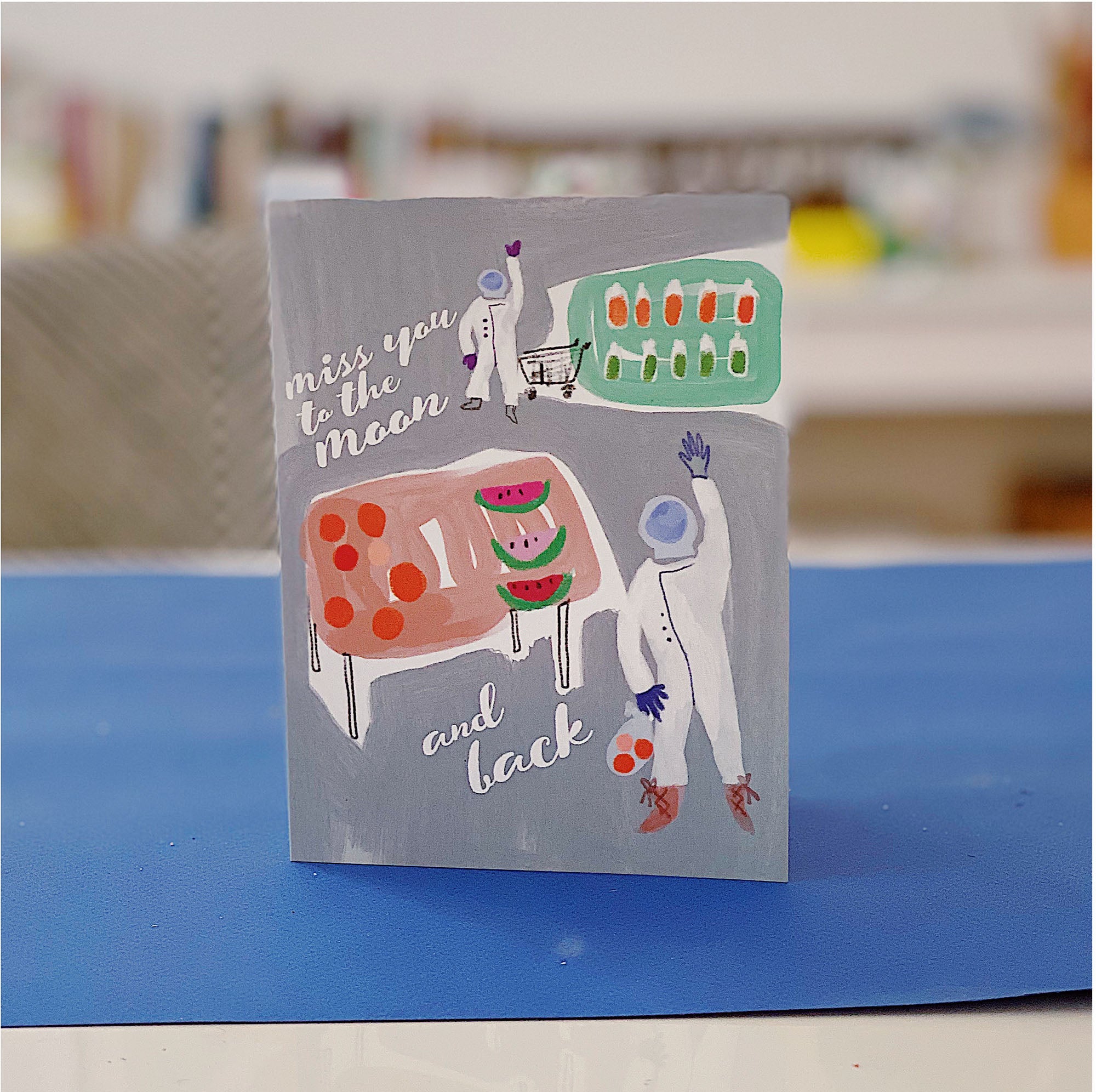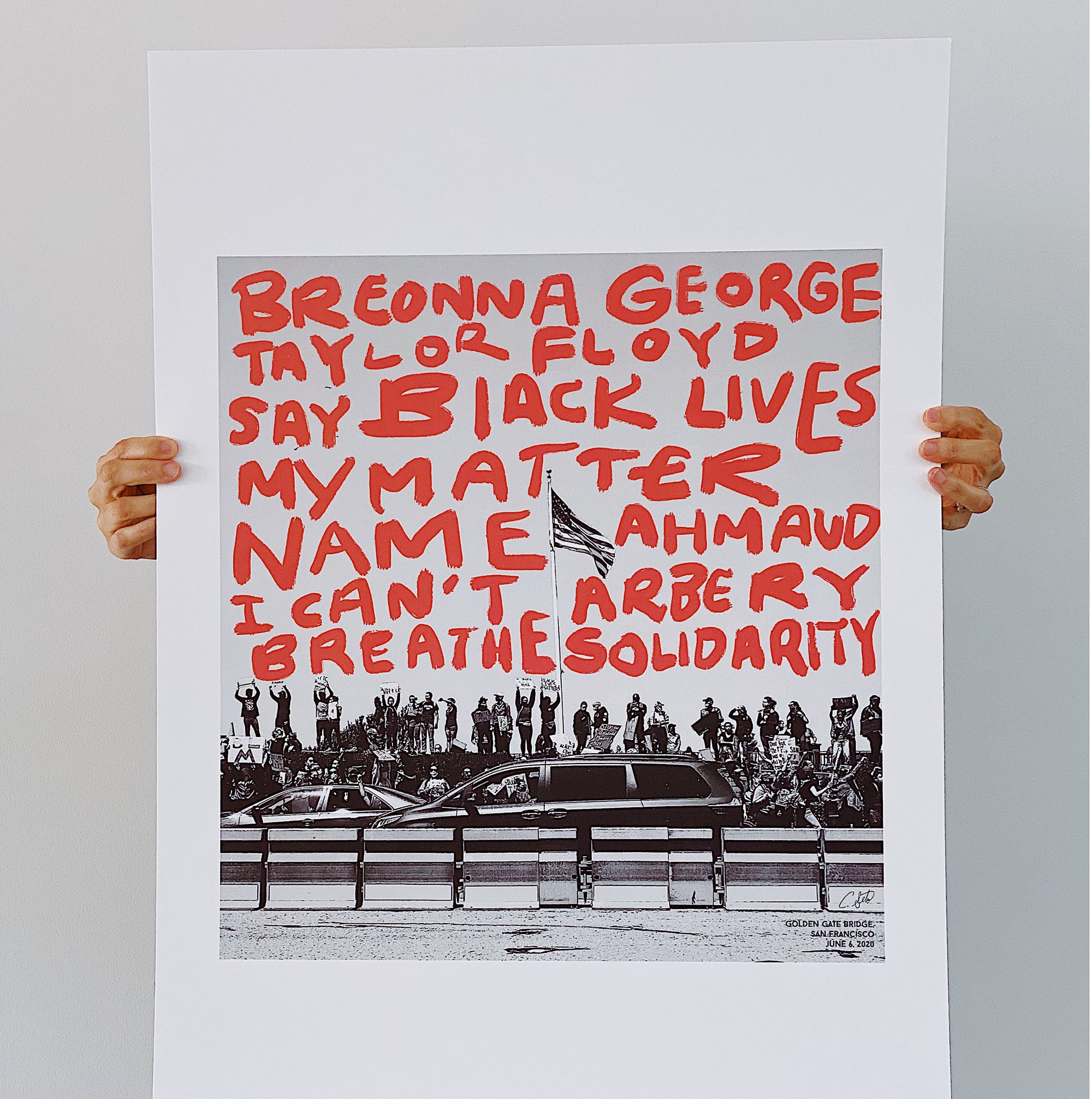Many artists graduate from formal art programs adept in color theory, brush techniques, and composition—but don’t know the first thing about business.
How can artists sell art and paintings online? How will they market themselves? Making a living as a career artist means understanding how to build an audience, how to price art products, and the unique requirements for shipping art. It means thinking like an entrepreneur.
Before ecommerce platforms, artists relied on third party gallerists, agents, and retailers to distribute work. The creator tools and sales channels of today were nonexistent. Now, independent artists can own their distribution streams, creating and selling their art online—and on their own terms.
For gallerists and curators, the shift in how we buy and sell in the past two decades has allowed these businesses to represent more artists and expand into selling affordable art prints online to reach larger audiences worldwide.
How to sell art online

Whether you’re a creator or a curator looking to make money selling art online, this step-by-step guide is for you. No matter what type of art you’re into—original acrylic paintings, digital art prints, sculpture—this resource has actionable advice for every artist.
In the following sections, we’ll cover the basics of selling art online for beginners and seasoned artists alike. Explore topics for every level including working with printers and dealing with plagiarism.
Contents
- Meet the artist experts
- Selling your own art versus selling works by other artists
- What to sell: original art versus reproductions
- Reproductions of art: open edition versus limited edition
- Printing art and choosing printers
- Photographing and scanning art
- Building your brand as an artist
- Setting retail prices for your art
- Where to sell art online: Your own ecommerce store
- Where to sell art online: More channels for selling
- Gallery exhibitions, pop-ups, and offline events for selling art
- Working with galleries to sell your art
- Marketing for art brands
- Packaging and shipping art
- Plagiarism issues and copyright protection when selling art
- FAQ
Meet the artist experts
We consulted successful artists, curators, and gallerists for their advice on everything you need to know to sell your art online. In this guide to selling your own artwork, their anecdotes will be woven into practical and actionable advice for any creative entrepreneur. Let’s meet our experts.
Cat Seto, owner and artist, Ferme à Papier

Cat Seto is an artist and author, and founder of Ferme à Papier, a San Francisco–based boutique representing unique goods from independent designers. Her stationery has appeared in multiple publications and landed her partnerships with brands like Anthropologie and Gap.
Maria Qamar, artist, Hatecopy

Best known by her artist moniker Hatecopy, Maria Qamar quit her advertising career to focus on art when her pop art paintings began to catch fire on Instagram. Now she works full time on her art, selling her own paintings in multiple formats, from art prints to books to printed merch.
Ken Harman, curator and gallerist

Ken Harman is the man behind the art empire that includes Spoke Art, Hashimoto Contemporary, and publishing company Paragon Books. Together, these businesses represent many global artists through physical galleries, online shops, and pop-up exhibitions.
What’s right for you: selling your own art or selling works by other artists?
There are two ways to sell art online: create or curate. Cat built her career on both by creating and selling her own work and representing the work of others in her boutique. Which one is right for you?
Create and sell your own art

As an artist, you are the creator, producing original art and/or reproductions of originals and selling directly to your customers or indirectly through a gallery, retail partner, or agent.
It’s never been easier for artists to sell directly, with emerging creator tools popping up seemingly every day. Depending on your style and medium, choose a sales channel where your desired audience hangs out. This is arguably the easiest way to sell art online for many.
Maria runs her own online shop, where she sells art prints and merchandise, eliminating the middleman and keeping her costs low. But she also leans on relationships with experienced galleries for exhibiting and selling original artwork.
If you’re learning how to sell your art, note that galleries can expose your work to new audiences. They may also have access to resources and professionals to help promote, exhibit, handle, and ship artwork.
Curate the works of other artists

If you’re not personally an artist but you have a great eye and a love of the art world, you can still get into the game of selling art as a curator. Some artists may be disinterested in marketing or figuring out the best way to sell art online and instead rely on gallerists, curators, and retail partners to handle this aspect of the business. As a partner to artists, you make a percentage of the selling price in exchange for your business knowledge and service.
There are several ways to work with artists to sell their art online—be it selling originals or prints to licensing works to be printed on merchandise or used in publication. “Most galleries offer an industry standard 50% consignment split for original art,” says Ken. “The artist provides the artwork, we do our best to sell it.”
What to sell: original art versus reproductions
The best way to sell your art online will depend on the nature of your art and your chosen medium. You may choose to sell your art, reproductions of that work, or both.
Fine artists using classic mediums and selling at high price points may choose to only sell originals, for example, while digital art, which can be reproduced without loss of quality, is great for prints and merch. However, most art created in 2D mediums have multiple options for generating unlimited sales on a single work.
Consider the following formats:
- Original art such as paintings, drawings, illustrations (Note: you can sell both the original art as well as prints of the same work)
- Limited- or open-edition prints (framed, unframed, or prints on canvas)
- Digital downloads (desktop wallpaper, templates, print-at-home art, etc.)
- Custom art made to order from a customer request or commissioned by a business (Note: Generally, this art would be one of a kind and not sold again as a reproduction)
- Merchandise (your art printed on hats, iPhone cases, mugs, t-shirts, enamel pins, greeting cards, stationery, etc.)
- Repeat prints on fabric, wrapping paper, or wallpaper
- Licensing work to other brands or publications (great for illustrators and photographers)
- Collaborations with brands (limited collection sold through the partner brand’s store)

Some mediums, like sculpture, are more difficult to reproduce or use for merchandise applications. But for those impossible to scan and print, there are still ways to generate additional income from a single design. For example, clay works may use the same mold to generate similar pieces, and 3D designs can be created over and over with a 3D printer.
Reproductions of art: open edition versus limited edition

Reproducing art on t-shirts or mugs, or as art prints means that a single work can bear fruit indefinitely—or for a limited time. There are two ways to approach selling your art as prints: open edition or limited edition.
What is open edition?
Open edition means printing and selling an unlimited number of products (reproductions or prints of an original work).
Benefits
- You can continue to profit from a single piece of art indefinitely while there is still demand for it.
- Your art can spread far and wide through the hands of happy customers who are never met with an “out of stock” warning.
Downsides
- The unlimited availability of your pieces may devalue your work overall
What is limited edition?
Limited edition means printing only a certain number of prints before they are gone. These are often numbered and signed by the artist to add value and authenticity.
Benefits
- The effect is much like that of a limited time offer: creating a sense of scarcity and urgency is an excellent marketing strategy
- The limited availability adds value to the art, meaning you can sell prints at higher price points
Downsides
- Because the demand is higher than supply, this creates a secondary market where buyers resell the pieces at inflated prices.

Spoke often opts for the limited edition strategy. “We work really hard to find things that are very special to sell. Things that are special should be treated like they’re special,” Ken says.
To help minimize reselling, Spoke will limit quantities of certain prints per customer. “Making sure that the real fans are actually the ones who are able to get the things that we sell is always a priority,” Ken says.
Printing art and choosing printers

Understanding how to sell your prints of your artwork comes down to getting very friendly with a printer, whether that’s your at-home inkjet or a company that handles the task for you. There are multiple options, from DIY to completely hands off, to help you sell art prints and other merchandise to your audience.
DIY printing
It’s possible to start selling your own artwork by creating quality prints yourself with high-quality paper, ink, and an at-home office printer. As a new artist, this method can keep costs low, but may be unsustainable as you scale over time.
“In the beginning, I would print, package, and deliver by hand every single poster that was ordered,” says Maria. “At some point the volume became so much that I couldn’t make time to draw. I was spending all of my days delivering and in transit.”
This method is usually limited to selling art prints on paper, but some specialty home printers may allow you to print on canvas paper or fabric designed specifically for this purpose.
Using a printing company
A local or online printing company can reproduce your work en masse and can even offer bulk discounts if you are printing many of the same piece. This can be the best way to sell art online if you have a small catalog and high sales volume of those pieces.
With this method, you’ll still be responsible for packaging and shipping the prints you sell online. These companies can often produce high-quality prints due to more advanced printers.
It’s important that we are the last sets of eyes inspecting, packaging, and shipping the product to our customers.
Cat Seto, Ferme à Papier
Cat often prints large batches for collection releases. While she does use print-on-demand services, the prints arrive at her studio first, rather than shipping directly to the customer. “It’s important that we are the last sets of eyes inspecting, packaging, and shipping the product to our customers,” she says.

Print on demand
Print on demand is the most hands-off and versatile option and the easiest way to sell art online—especially if you plan to sell your work printed on merch like t-shirts or caps.
Print-on-demand services generally integrate with your online store. When an order is placed, the integration triggers that piece to be printed and shipped directly to the customer. This is a great option for selling art on a budget, as there is no need to invest in equipment or inventory.
When the number of orders exceeded her capacity to print and ship work herself, Maria upgraded to using a print-on-demand company. “All I have to do is upload and let it do the work for me,” she says. “Now I can focus on actually creating the artwork and connecting with people.”
Print-on-demand products don’t just stop at paper prints. Your art can be printed on a number of items from phone cases to stickers to sell.
💡 Tip: Before you start selling your own artwork this way, request samples from the printer so you can inspect the colors and quality of the print. This is especially important if printed items will be sent directly to your customers.
Photographing and scanning art

Photographing and representing your products clearly and accurately is important for any online small business. Without the ability to feel a product, potential customers need to get the best sense of what they’re buying through clear and detailed images.
If you have a bad image of your work or the image doesn’t represent the work accurately, you’re going to have a harder time selling it.
Ken Harman, Spoke Art
Selling art online is no exception. “If you have a bad image of your work or the image doesn’t represent the work accurately, you’re going to have a harder time selling it,” says Ken. Or, you’ll be stuck dealing with unhappy customers and processing returns.
Photographing art to sell
Product photography for art is a little trickier than other products, and a basic light setup may still cause glare or color irregularities. Consider hiring a professional to shoot larger works or art with any three-dimensional or glossy elements.

📚 Read more:
- DIY Guide to the Perfect Product Photography Setup
- The Complete Guide to Ecommerce Photography
Building your brand as an artist

As an artist learning how to sell your artwork, your brand may evolve as a natural extension of your art. Your chosen style and medium will define you as an artist and you will naturally attract fans and buyers based on this alone. However, there are many decisions you will need to consciously make when you start to think of yourself as a business as well as an artist.
Because art is a personal and sometimes emotional purchase, your brand story as an artist could factor into someone’s decision to buy. And other business assets like packaging and site design should mirror or complement the visual aesthetic of the work itself.
Your branding exercise should answer the following:
- Do you create and sell art under your own name, a pseudonym, or a brand name?
- How will you approach brand storytelling? How much of your personal story will you tell?
- Do you have a mission, values, or a cause that you want to communicate through your brand?
- Outside of the art itself, what is the visual direction of your brand identity? What’s the tone of your communication?
- What branding assets do you need? Even without design skills or the budget to hire a graphic designer, you can generate a logo and execute branding design with free and simple tools.
The answer to these questions will help you build a set of brand guidelines that will form the foundation for website design, marketing materials, etc. If you eventually scale your business, these guidelines will help you maintain brand consistency as you delegate tasks to staff or other partners.
Many artists build fan bases based on their online personas or personal brands that are closely tied to their art. Tatiana Cardona, also known as Female Alchemy, has chosen to put her face at the center of her social media strategy:

In collaborating, I think it’s important to not only stay true to your brand, but to be able to listen and be proactive to whomever you are collaborating with.
Cat Seto, Ferme à Papier
For Cat, the causes closest to her heart are central to her brand. While she recently refocused to work on AAPI themes, this isn’t the first time she’s made a statement with her work. Ferme à Papier launched a Saving Faces collection highlighting the stories of women and underrepresented groups.

Cat’s brand values influence the types of projects she takes on with brands and clients. “In collaborating, I think it’s important to not only stay true to your brand,” she says, “but to be able to listen and be proactive to whomever you are collaborating with.”
📚 Read more:
- How to Start Your Own Brand From Scratch in 7 Steps
- What is a Personal Brand? 7 Steps to Building the Business of You
Setting retail prices for your art

How do you sell art online—and actually make money doing it? Making a living as a working artist is possible if you know how to value and price your work. Pricing art is challenging because it doesn’t necessarily fit neatly into typical pricing strategies.
Pricing original art
Running any business that will be sustainable in the long term involves being profitable at some point. To achieve this, you will need to price your art accordingly. If you’re just beginning to experiment with how to sell your art and don’t have a widely known name, you can start with a simple formula to price your original art:
Your cost to sell and market the piece + material costs + other expenses + your markup (profit) = retail price
For this method, it’s helpful to factor in the time you spent creating the art. It is typical for artists to undervalue their time and work, especially at the beginning.
Knowing what your products stand for and what you aren’t willing to compromise are key components in driving decisions about pricing.
Cat Seto, Ferme à Papier
Where the formula above fails is that the value of art is subjective and not necessarily dependent on concrete details like material cost or labor hours. Famous artists can fetch exponentially more for a piece that has roughly the same creation costs as that of a new artist. Check the market to compare your pricing to similar artists at similar levels and adjust accordingly.
💡 Tip: If you are selling through a physical or online gallery, the gallery will usually take half of the final selling price. You can usually work with gallerists, who are experts at valuing and pricing art, to set a price that makes sense for you, the gallery, and the market.
Pricing art prints
Selling art prints or other types of reproduction can follow a more simple pricing formula:
The cost of printing + your cost to sell and market the print + other expenses + your markup (profit) = retail price
Your markup may be on a scale depending on whether you sell open- or limited-edition prints. Other expenses may include office supplies, software or app fees, professional services, studio rent, and more.
“Knowing what your products stand for and what you aren’t willing to compromise are key components in driving decisions about pricing,” says Cat. For her, printing on sustainable paper was a must-have, even though it would drive up material costs and ultimately the retail price. Communicating these decisions to the customer is important, especially if your prices are higher than average.
Where to sell art online: Your own ecommerce store

The best way to sell your art online is through your own ecommerce store. First, take a few minutes to create your store. At this point, you can set it up as a trial and tinker with it for two weeks before committing. You’ve already done a lot of the work if you’ve established brand guidelines, pricing, and business model (originals, prints, or merch)—this part is simply assembly.
From: https://www.shopify.com/blog/211990409-how-to-sell-art-online

